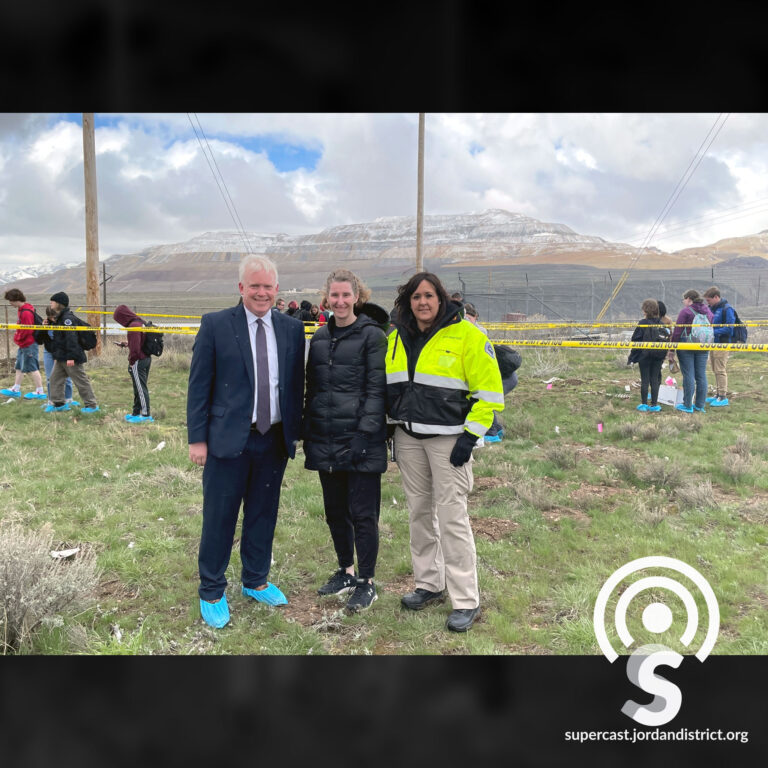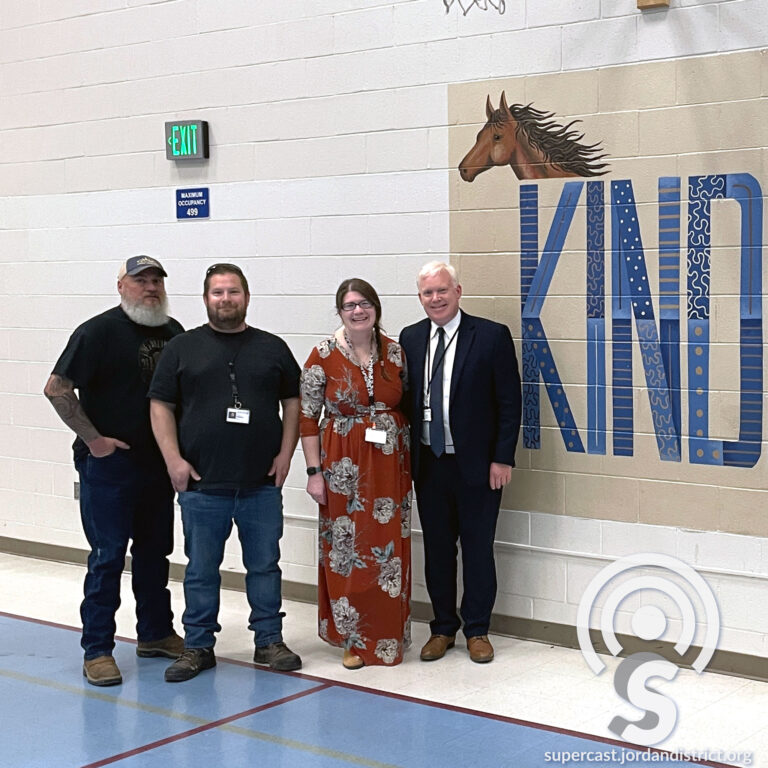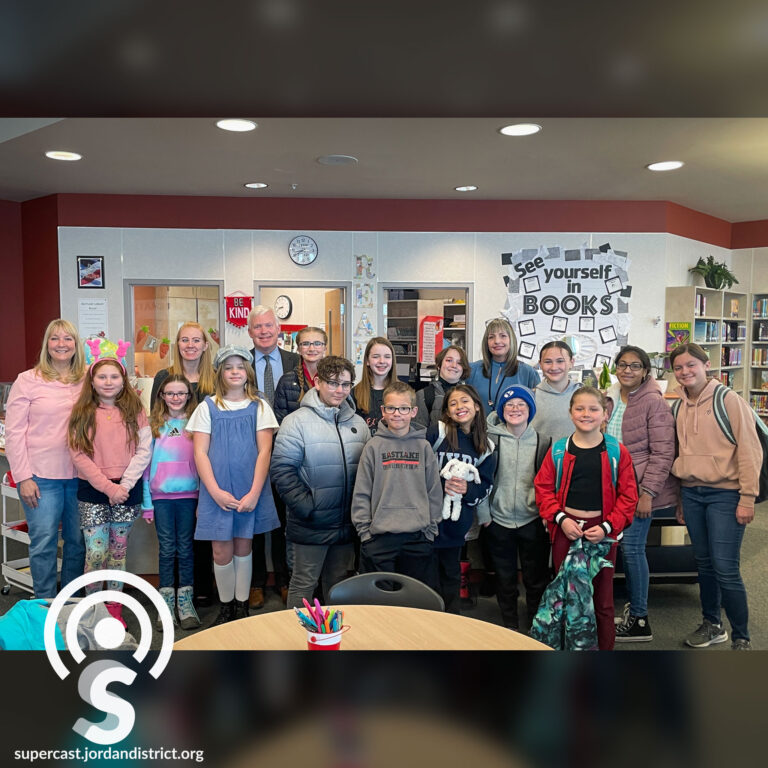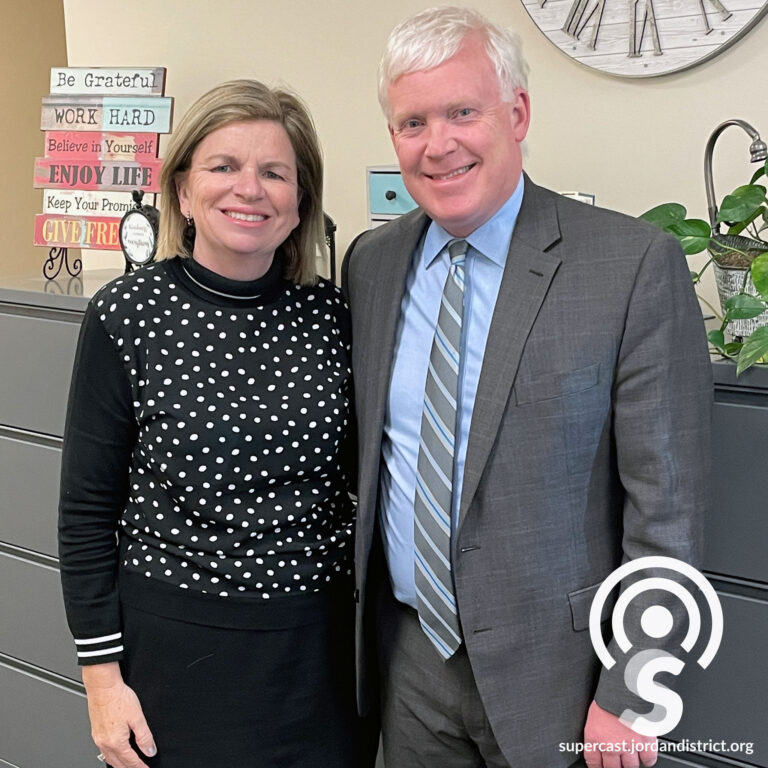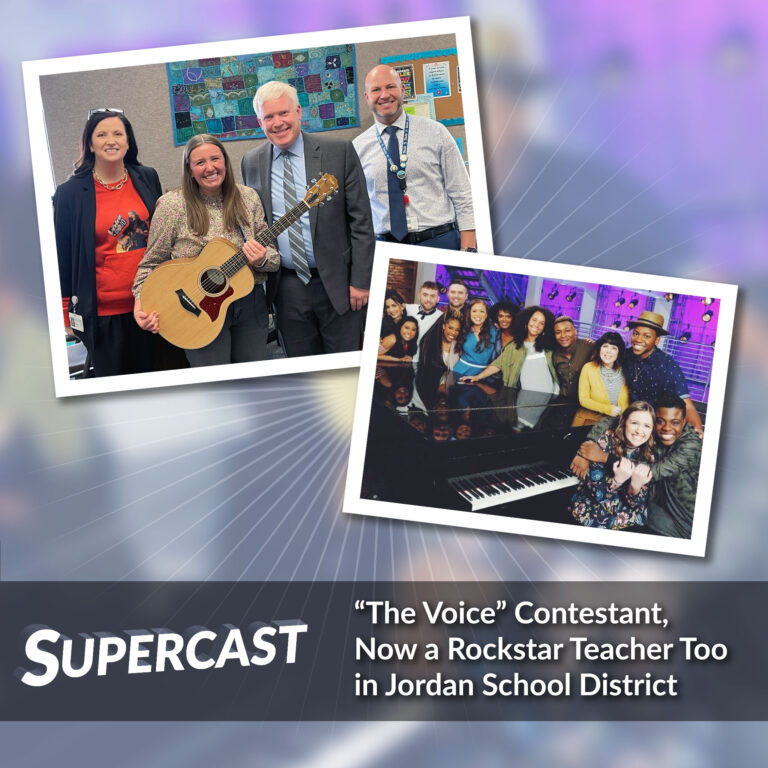It is a high school Medical Forensics class which focuses on the proper way of documenting and processing a crime scene and on this day, it does not involve work in the classroom.
On this episode of the Supercast, we will take you on a unique field trip where forensics students are getting their hands dirty, with hands-on learning, digging deep into the science of medical forensics. Surrounded by police cars and crime scene tape they are crime solving students in action.
Audio Transcription
Anthony Godfrey:
Hello and welcome to the Supercast. I'm your host, Superintendent Anthony Godfrey. It is a high school medical forensics class which focuses on the proper way of documenting and processing a crime scene and on this day, it does not involve work in the classroom.
On this episode of the Supercast, we take you on a unique field trip where forensics students are getting their hands dirty, with hands-on learning, digging deep into the science of medical forensics surrounded by police cars and crime scene tape. They are crime-solving students in action.
I’m here with Cynthia Cox out in Copperton, out in the field with her medical forensics class and with the law enforcement class as well. So introduce yourself and tell us a little bit about these classes and today's experience.
Cynthia Cox:
Well, my name is Cynthia Cox and I teach the medical forensics class at Bingham. All year long we've been talking about crime scene investigation, crime scene analysis, identification of evidence, analysis of evidence, packaging of evidence, and so this is kind of a culminating activity where the students come out and it's led by the police department. So the students are getting a real-world view of how to solve a crime from beginning to at least evidence packaged and sent back to the lab.
Anthony Godfrey:
Well, we have a gloomy snowy day that you might have ordered for dark work like this. It's the perfect setting. Tell me about the skills that students learn in class that lead up to this experience.
Cynthia Cox:
Well, we talk all about observation skills and turning off filters during observation, trying to make sure that students are coming in looking at evidence unbiased. We try to, we teach them about how to package all different types of evidence, not just a screwdriver, a piece of wire, but biologic evidence, drug evidence, blood evidence. And so there we teach bone analysis, we look at fingerprint analysis, we look at blood spatter analysis, and through all of those activities we're working on, you know, other workplace skills like problem-solving skills and teamwork skills.
Anthony Godfrey:
Tell me about the bone analysis and the blood splatter analysis.
Cynthia Cox:
Okay, so with blood spatter it can tell a story. We can, based on are we seeing large drops? Is this somebody that was maybe walking away from after they were injured? Or is this a really fine mist that may have come from a fast-moving weapon like a gun? So the angles that spatter hits a surface can tell us whether that person was standing up, whether they were sitting down, were they lying down. We can identify how many times a person might have been hit with blood spatter analysis. So there's lots of things we can learn from that.
With bone analysis and what they're looking at out here, a lot of animal bones that we've put out here, and we allow them to decompose before the students come out here. We can identify gender, we can identify ancestry, we can identify age from the bones, we can identify some of the injuries that might have occurred and left marks on the bones when we're trying to put all the pieces together and figure out what happened.
Anthony Godfrey:
So you indicated that you have animal remains out here that are used as evidence.
Cynthia Cox:
Yes.
Anthony Godfrey:
So tell me about that. That's how you helped create the crime scene.
Cynthia Cox:
Yeah, so these are all legally acquired animal remains that taxidermists have given to me. And so we put them out here and allow them to decompose. And then the students collect the evidence that's already completely decomposed 'cause they don't like dealing with the flesh.
Anthony Godfrey:
You’ve really gone all in with getting things early enough to allow them to decompose. That's really, that's lesson planning at another level.
Cynthia Cox:
Well, we've been putting stuff out here every year for about nine years, so.
Anthony Godfrey:
You've got it down.
Cynthia Cox:
Yeah.
Anthony Godfrey:
Now tell me about the involvement of the police. As I drove out here, I saw the truck and the flashing lights and I knew something was up.
Cynthia Cox:
Yeah.
Anthony Godfrey:
It definitely gives that real feel. They're working with the police right now, walking through with police officers in uniform, walking them through the crime scene. It's pretty exciting.
Cynthia Cox:
Yeah, so I feel like that's one of the benefits to it. We get that work-based learning feel. It's one thing for a classroom teacher to stand up there and teach all these components. But when they come out here with the police officers who do this every single day, all day long, they get a little bit more of that real-world experience, trying to really bring work-based learning into the classroom as much as we can, or outside of the classroom as we may. So I set this up through our SRO, and then he reaches-- -
Anthony Godfrey:
School resource officer for those listening.
Cynthia Cox:
Yep. And then he reaches out to the forensics division at the South Jordan Police Department.
Anthony Godfrey:
So do you draw attention? Do people wonder what's going on when the police are out here and we're scouring the landscape with police tape and everything?
Cynthia Cox:
Well, just like it was interesting to you when you walked up, we've already had Rio Tinto security come up and check on us to make sure everything was okay and see what was going on 'cause they saw the police tape and the flashing red and blue lights and--
Anthony Godfrey:
You told them no problem, we're just solving crime.
Cynthia Cox:
Yep, that's right.
Anthony Godfrey:
Well, it's about the most engaged learning you can imagine. I'm just looking out at a couple of dozen students with police officers and do not cross police tape and evidence and it's really exciting. So thank you for providing such a great experience for them today. Tell me, does this change their view of the crime shows and movies that they watch? Does it shift their perspective?
Cynthia Cox:
I hope so. We talk about that quite a bit in class, the fact that a crime is not solved in 45 minutes, that a collection of evidence alone can take 8, 9, 10, 12 hours, and then there's all the analysis and then all the legal work and the paperwork and everything. So we talk about that in depth in class.
Anthony Godfrey:
So what is it that draws students to a class like this? Is it they want to be in law enforcement, they want to be an attorney, they want to know more about you know a medical approach to solving problems? What is it that draws them?
Cynthia Cox:
I think most of the time they've they've seen the shows and those are interesting to them and so then they want to learn more. We talk about it throughout the school, they see some of our mock crime scenes that we set up during the school day as well.
Anthony Godfrey:
Mock crime scenes must be really good advertisement for that class.
Cynthia Godfrey:
Yeah, we set those up multiple times throughout the year in the building and the students are able to then go through and practice collecting evidence. They stage them so they create those crime scenes that we do in class and they moulage each other, and they practice but then this is taking it to a whole different level.
Anthony Godfrey:
This is impressive. We're now in the area of the decay and with the bones out there. Kids are measuring things on the ground, working in teams, scouring the landscape, packaging evidence all under the watchful eye of South Jordan Police. It's really exciting. It's really cool to see this level of engagement. So beyond the specific skills of forensics, what are some of the other general skills that you hope students take away from this class?
Cynthia Cox:
Number one, I want them to have an appreciation for law enforcement, right? I want them to understand what really has to go into crimes and evaluation. You think about a TV show and it lasts 45 minutes and they've solved the whole crime.
Anthony Godfrey:
Right. Everything gets tied up pretty neatly.
Cynthia Cox:
Yeah. And in real life, it doesn't happen that way.
Anthony Godfrey:
Right.
Cynthia Cox:
So, I want them to have that appreciation and kind of that real-world view. We teach a lot of analytical skills in this class, information processing, you know, how to put all the pieces of the puzzle together, teamwork skills. It's another big thing that we work on in this class.
Solving a crime isn't just a one-person deal, you know, you're working with a medical examiner, you're working with an investigator, you might be working with an attorney or law enforcement, everybody has to come together to try to solve that. So we work a lot with teamwork skills, some of those life skills that they can take with them into other professions as well.
Anthony Godfrey:
Outstanding. Well, it's a great class experience obviously given by an award-winning teacher and they're very lucky to have you and to have the chance to have experiences like this. So thank you for making learning so meaningful and real for these students.
Cynthia Cox:
Thank you. Thanks for coming out here.
Anthony Godfrey:
Stay with us. When we come back, more with our crime-solving students in Bingham High's medical forensics class.
Break:
Does your student want to become a veterinarian? Commercial pilot? Programmer? Maybe they want to make a difference as a dental assistant. These are just some of the programs offered as part of Career and Technical Education. CTE in Jordan School District. CTE provides the technical skills needed to prepare students for future employment or for a successful transition to post-secondary education. Career and Technical Education provides work-based learning opportunities. We partner with industry experts to offer apprenticeships and internships with students working in the real world at real jobs while going to school. The CTE experience starts in our elementary schools with the Kids' Marketplace and grows through middle and high school. To explore all CTE has to offer in Jordan School District visit cte.jordandistrict.org today and let's get your child started on the pathway to a profession.
Anthony Godfrey:
Hi Lexi, we're out here in the field by Copperton doing investigative work. Tell me what class you're in.
Lexi:
It's the Medical Forensics class at Bingham. It's one of the awesome classes we teach there. We're just learning about investigating crimes and looking for evidence and it's a blast out here.
Anthony Godfrey:
And tell me what you're looking for out here.
Lexi:
Oh, we're looking for anything that could have evidence. So in the class, we've learned about all sorts of evidence, biological transfer, stuff like that. So we're looking for things that could have DNA on them, things that could have skin or hair, saliva or things that could be used as a weapon, so any tools that wouldn't grow in the middle of a field.
Anthony Godfrey:
What's the specific crime that you're trying to solve?
Lexi:
Somebody went out here, we had a missing person, but one of the teams has found a head so they're no longer missing.
Anthony Godfrey:
Oh, okay. So it has changed to a different kind of investigation at this point.
Lexi:
Yes.
Anthony Godfrey:
All of this is fictitious for those of you who may have dropped in partway through the podcast. Now it is cold, it is kind of the perfect setting for grim work of the type that you're doing right now. Tell me about looking forward to this experience as you've been learning things in class.
Lexi:
It's just been awesome, it's cool because in most classrooms it's hard to find any sort of like hands-on, especially a class like this where we're dealing with like criminal things. You can't often find that, but it's cool that we have this experience.
Anthony Godfrey:
And is this something that you think you might want to pursue long-term as a career?
Lexi:
Not especially, not because of the class I just already have other ambitions, but it's been really good to apply to it. I want to be a nurse and so there's things that have been like applicable throughout and even different types of nursing this can still apply well.
Anthony Godfrey:
And problem-solving and working with teams and just there's a lot of that can be applied from this to becoming a nurse.
Lexi:
Definitely. Along with that, we just learn lots about like the human body and different stuff because like when we are looking for evidence, we're looking for hair and drugs and stuff like that. And then in nursing, we're looking for like evidence of things that could be wrong with the body. So it's cool to learn about the different structures and then apply them differently.
Anthony Godfrey:
And you'll look at every crime show or movie in a different way for the rest of your life now.
Lexi:
Oh definitely.
Anthony Godfrey:
Well, I'll let you get back to solving crimes and making this a safer place for everyone.
Lexi:
Okay, thank you.
Jody Skog:
My name is Jody Skog. I am the crime scene and evidence supervisor.
Anthony Godfrey:
So tell me about this experience with the students.
Jody Skog:
It is super fun to be able to come out here and have them see what we see and when they have all their markers I'm like oh this is an evidence person's worst nightmare because there's like 150 markers.
Anthony Godfrey:
Yeah.
Jody Skog:
But just to see how excited they get is really fun because it's the first step of a career for them.
Anthony Godfrey:
So tell me what your day-to-day job is like when you're not helping students solve crime.
Jody Skog:
A lot of my job is running the evidence division and so it's booking any property that the evidence book in. It could be processing, looking for fingerprints, DNA, submitting stuff to the crime lab, processing actual crime scenes.
Anthony Godfrey:
Well, thank you for what you do, and thank you for taking the time to help these students learn these skills.
Jody Skog:
We just did an internship with or a job shadow with a 14-year-old.
Anthony Godfrey:
Oh really?
Jody Skog:
And then she wanted to come back, so we had her come back and she actually helped us process some evidence.
Anthony Godfrey:
And do you think she might want to pursue this?
Jody Skog:
I think she will.
Anthony Godfrey:
Yeah?
Jody Skog:
Yeah.
Anthony Godfrey:
Tell me about what sparked it for you, what made you want to pursue this as a career?
Jody Skog:
I was a police officer for seven years. And then this just kind of fell into my lap and now I run the whole division.
Anthony Godfrey:
And what made you interested in being involved in law enforcement?
Jody Skog:
My dad was a police officer for 30 something years. And so he always told me over his dead body. And so he got sick of me talking about it. And he says, "Do you wanna do it, do it.” And so I started when he retired.
Anthony Godfrey:
Oh wow.
Jody Skog:
So I'm on my 22nd year.
Anthony Godfrey:
Wow, that's amazing.
Jody Skog:
Three and a half years left.
Anthony Godfrey:
Yeah. So you're going for 25, a little over?
Jody Skog:
I'm gonna do probably just the 25 and I’m tired.
Anthony Godfrey:
Yeah.
Jody Skog:
And so Audrey's just started. She's been with us for four months. So what they teach you in college isn't necessarily what happens on the job. So it's kind of an eye-opener, but we were telling the kids, check with departments, get involved in like the cadets. Sandy City has the Explorer program.
Anthony Godfrey:
Yeah.
Jody Skog:
So if they want to be a police officer, if they want to do crime scenes, it's a great way to start.
Anthony Godfrey:
Good. Tell me what do you observe as you are working with students? You see some different approaches I assume.
Jody Skog:
I think they have the way they look at things is really interesting but they're on the right path. Fingerprints, DNA, the females are a little bit more methodical than the boys are. It's kind of fun to watch because the girls are really slow and really think it out and the guys are just like.
Anthony Godfrey:
Running through, huh?
Jody Skog:
Running through.
Anthony Godfrey:
Let's crank it out. Do you ever get to enjoy any crime shows or any movies at all or are you just able to point out all the things that are wrong?
Jody Skog:
I laugh at them. Right. I'm like, we can't solve a crime in 24 hours.
Anthony Godfrey:
Is there anybody who does it right? Is there a show where you say this show is really pretty close to authentic?
Jody Skog:
No.
Anthony Godfrey:
[LAUGHTER] So there's nothing out there.
Jody Skog:
No. But I get a kick out of them. I love them all.
Anthony Godfrey:
Well, I can keep watching them in my ignorant state and enjoy them because I don't know better.
Jody Skog:
It’s fun. Right.
Anthony Godfrey:
Right.
Jody Skog:
So our labs are getting faster and faster, where a rape would take a couple of years to solve. And now we're getting the results back in a couple of months. So technology is increasing.
Anthony Godfrey:
What's an aspect of the new technology that might surprise people?
Jody Skog:
They're getting manpower, before they used to have like one expert.
Anthony Godfrey:
Yeah.
Jody Skog:
And so we're getting more and more people that are loving forensics and they're getting, getting educated. So the field is growing.
Anthony Godfrey:
Well, hopefully, the students here today can help create a pipeline for some other, some other great folks to come help out.
Jody Skog:
We need smart people.
Anthony Godfrey:
So Kelan you're here solving crime with your friends, right?
Kelan:
Yes, correct.
Anthony Godfrey:
And I see your shirt says Bingham Medical Forensics with a bloody B under a magnifying glass. I like the logo.
Kelan:
I do too.
Anthony Godfrey:
Tell me about this class and this experience.
Kelan:
Well, we go through a lot of things, such as bone analysis and blood work, and we study some of the body, the body features, and anatomy, we really cover a whole lot in this class. It's really fun.
Anthony Godfrey:
And have you been looking forward to this field experience?
Kelan:
I'm really interested in the medical field. I don't know what I wanna do, but yeah, this really intrigues my interest. I'm really intrigued.
Anthony Godfrey:
So it's allowed you to learn some about the human body and sometimes it may be from a dark perspective, you know, the bad things that can happen and how you can detect how it happened and maybe who did it. So I like that you know that you wanna go in the medical field, but you're open to which direction that'll take you.
Kelan:
Yeah, exactly.
Anthony Godfrey:
Well, it's great to talk with you and I'm glad you're having such a good experience in the class and good luck with whatever medical career you pursue.
Thanks for joining us on another episode of the Supercast. Remember, education is the most important thing you will do today. We'll see you out there.

